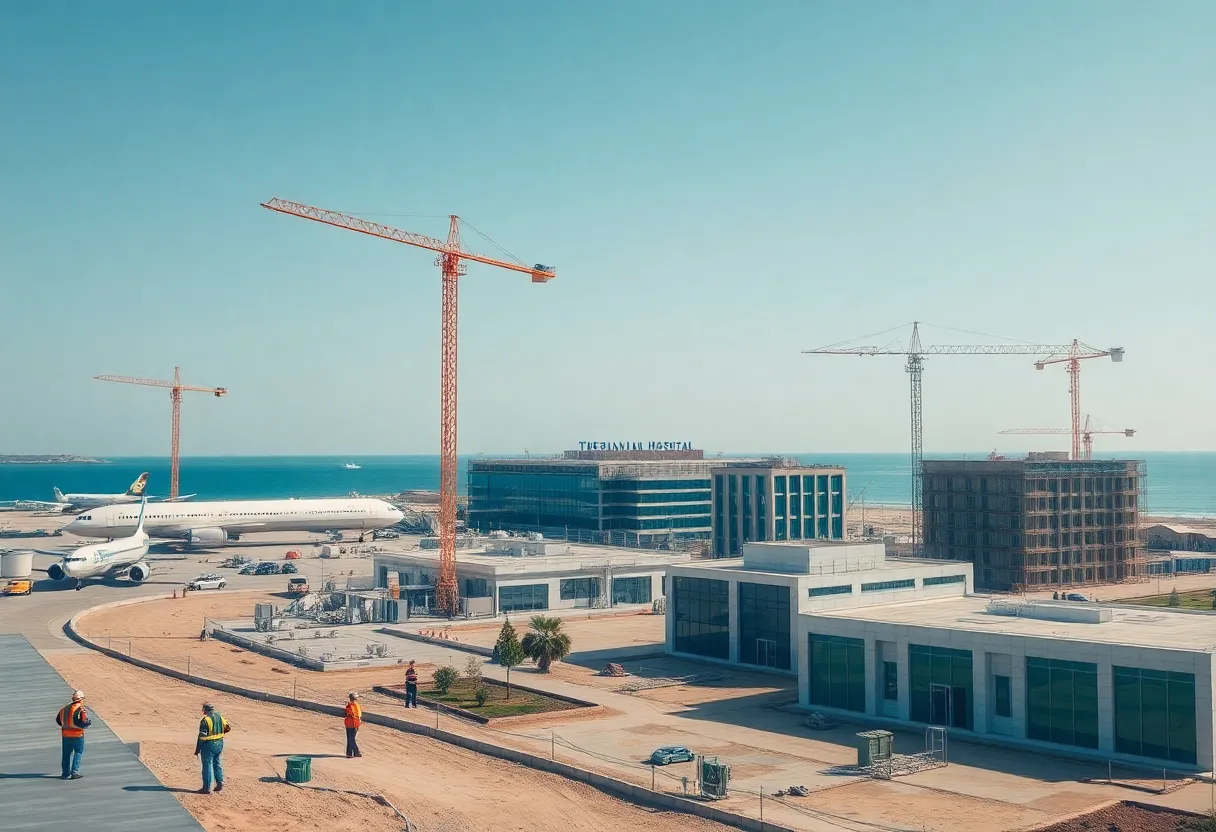, October 12, 2025
News Summary
Major regional investments are advancing across Latin America and the Atlantic: the Development Bank of Latin America and the Caribbean (CAF) approved a US$96 million loan for Cabo de Santo Agostinho to fund sanitation, drainage, roads, social infrastructure and a new Women’s Hospital benefiting over 200,000 residents. In Los Cabos, rapid population growth is prompting airport expansion, new roads and desalination projects to address water and housing pressures. Cape Verde unveiled a national 5G strategy to boost connectivity, smart tourism and digital services. Together these initiatives aim to strengthen resilience, public services and long-term economic growth.
Major infrastructure moves in Latin America and Africa: CAF approves loan for a Brazilian city; Los Cabos plans major airport, road and desalination works amid fast growth; Cape Verde launches 5G strategy
Development and infrastructure projects across three regions moved forward this month with new financing, ongoing construction and national technology planning. The board of a regional development bank approved a US$96 million loan to support an urban upgrade in a Brazilian coastal municipality, while a fast-growing Mexican resort municipality presses ahead with airport, road and desalination projects to serve a population that could nearly double by 2035. Meanwhile, an island nation in the Atlantic launched a national plan to deploy 5G as part of a digital growth strategy.
CAF loan for Cabo de Santo Agostinho, Brazil
On October 10, 2025, the board of the Development Bank of Latin America and the Caribbean approved a US$96 million loan for the municipality of Cabo de Santo Agostinho in Pernambuco. The amount is part of a larger US$120 million operation to finance an Infrastructure and Urban Development Program aimed at the city’s more than 200,000 residents.
Planned investments cover sanitation, urban drainage, road paving and re‑development, bicycle lanes, containment of risk areas, environmental recovery and improvements in solid waste management. The program also foresees expansion and modernization of public recreational, cultural, health and educational facilities, creation of parks and sports sites, and measures to strengthen sustainable tourism by adapting and recovering the coastal strip. A major milestone is the construction of a new Women’s Hospital intended to expand access to specialized services and address gender equity in health care.
The bank said the operation is part of broader support for more inclusive, resilient and sustainable cities in the northeastern region. Administrative contact details for the financing institution were listed as part of the announcement for those seeking further information.
Los Cabos: rapid growth and mounting infrastructure demand
The municipality that was home to about 44,000 residents in 1990 grew past 350,000 by 2020 and is projected to reach between 600,000 and 650,000 residents by 2035 if current trends continue. Annual growth has been running at roughly 14–16%, far above national averages. The area already accounts for about 44% of the state’s population and could hit 50% by 2035.
Urban planning has evolved since a first master plan in 1999 and a major update in 2013 that emphasized responsible growth to 2040. A third edition of the plan is expected soon and will include a participatory public element, though the scale of public engagement remains uncertain. The municipality hosts just over 17,400 foreign residents today; another roughly 10,000 foreign residents may arrive within a decade, while most newcomers are expected to be nationals from other Mexican states.
Airport expansion and visitor capacity
Passenger traffic has surged: the airport recorded more than 7.5 million passengers in 2024, a 40% rise from 2021. A master development program across a group of airports includes an investment of 7 billion pesos (around US$370 million) specifically for the local international airport. Plans call for consolidating operations into a single terminal by 2029, expanding the international terminal to handle domestic flights, adding three gates, nearly 20 new self‑service kiosks, a roughly 33% larger baggage area and additional immigration checkpoints. The upgrades aim to increase throughput by up to 40%.
Roads, the Interurban Axis and traffic pressures
Road projects are intended to ease congestion but are also sources of near‑term disruption. A major interchange project used by more than 60,000 vehicles per day is under construction and was about 25% complete as of late August 2025, with an expected finish around summer 2026. A planned third route between Cabo San Lucas and San José del Cabo, the Eje Interurbano, would run about 20.3 kilometers and cost an estimated 5 billion pesos. Land agreements covering multiple ejidos and private owners were reached in August 2025, but federal approvals and funding are still required before construction can start.
Water shortage and desalination efforts
Los Cabos faces a current water deficit of about 600 liters per second. Authorities are advancing a second public‑private desalination plant in Cabo San Lucas that was reported around 41% complete and targeted for delivery in October 2026. The two desalination facilities combined are projected to yield about 650 liters per second, enough to cover the present shortfall but potentially insufficient if population growth accelerates. The second plant involves local water utilities and private partners and has seen roughly 1.145 billion pesos invested so far. Water scarcity has prompted neighborhood protests and high-level government attention.
Housing and land pressures
Demand for housing is outpacing supply, especially for affordable and rental units. Prime coastal tracts are largely reserved for high‑end resorts and residential projects, while affordable initiatives struggle to secure land at workable prices. Expansion is likely to push into outlying zones, fueling debates over environmental protection and long‑term community resilience.
Cape Verde launches national 5G strategy
Separately, Cape Verde announced a national strategy to deploy 5G as part of a broader digital project backed by international funding. The plan aims to reach roughly 90% internet penetration by 2026, improve connection speed and quality, and position the country as a regional hub for telecommunications, innovation and entrepreneurship by 2030. Economic studies underpin the strategy, which identifies strong potential gains across smart tourism, digital health, education and agriculture through 2036. Implementation will involve regulators, operators, academia, private partners and the diaspora.
Taken together, these developments underline a common pattern: large capital projects promise long‑term benefits but require careful sequencing, public engagement and financing to manage near‑term disruption and ensure benefits reach local communities.
Frequently Asked Questions
What is the purpose of the CAF loan to Cabo de Santo Agostinho?
The loan supports an infrastructure and urban development program covering sanitation, drainage, mobility, social infrastructure, tourism adaptation, environmental recovery and construction of a women’s hospital, among other improvements.
How fast is Los Cabos growing and what are the main pressures?
Los Cabos grew from about 44,000 residents in 1990 to over 350,000 in 2020 and could reach 600,000–650,000 by 2035. Main pressures include water supply, housing affordability, airport and road capacity, and environmental impacts from rapid development.
When will the airport and desalination projects be completed?
The airport expansion aims to consolidate terminals and increase capacity by 2029. A second desalination plant has a target completion around October 2026, though schedules can change with funding and political factors.
What does the Cape Verde 5G strategy aim to achieve?
The national 5G strategy aims to expand internet access to about 90% by 2026, improve speeds and digital services, and foster sectors like tourism, health, education and agriculture while positioning the country as a regional digital hub by 2030.
How will these projects affect local residents in the short term?
Short‑term effects include construction traffic and disruptions, temporary strain on services during upgrades, and potential land‑use conflicts. Long‑term impacts depend on timely completion, inclusive planning and measures to protect affordable housing and natural resources.
{
“@context”: “https://schema.org”,
“@type”: “FAQPage”,
“mainEntity”: [
{
“@type”: “Question”,
“name”: “What is the purpose of the CAF loan to Cabo de Santo Agostinho?”,
“acceptedAnswer”: {
“@type”: “Answer”,
“text”: “The loan supports an infrastructure and urban development program covering sanitation, drainage, mobility, social infrastructure, tourism adaptation, environmental recovery and construction of a women’s hospital, among other improvements.”
}
},
{
“@type”: “Question”,
“name”: “How fast is Los Cabos growing and what are the main pressures?”,
“acceptedAnswer”: {
“@type”: “Answer”,
“text”: “Los Cabos grew from about 44,000 residents in 1990 to over 350,000 in 2020 and could reach 600,000–650,000 by 2035. Main pressures include water supply, housing affordability, airport and road capacity, and environmental impacts from rapid development.”
}
},
{
“@type”: “Question”,
“name”: “When will the airport and desalination projects be completed?”,
“acceptedAnswer”: {
“@type”: “Answer”,
“text”: “The airport expansion aims to consolidate terminals and increase capacity by 2029. A second desalination plant has a target completion around October 2026, though schedules can change with funding and political factors.”
}
},
{
“@type”: “Question”,
“name”: “What does the Cape Verde 5G strategy aim to achieve?”,
“acceptedAnswer”: {
“@type”: “Answer”,
“text”: “The national 5G strategy aims to expand internet access to about 90% by 2026, improve speeds and digital services, and foster sectors like tourism, health, education and agriculture while positioning the country as a regional digital hub by 2030.”
}
},
{
“@type”: “Question”,
“name”: “How will these projects affect local residents in the short term?”,
“acceptedAnswer”: {
“@type”: “Answer”,
“text”: “Short-term effects include construction traffic and disruptions, temporary strain on services during upgrades, and potential land-use conflicts. Long-term impacts depend on timely completion, inclusive planning and measures to protect affordable housing and natural resources.”
}
}
]
}
Key project features at a glance
| Project / Location | Key facts | Budget / Timeline | Expected impact |
|---|---|---|---|
| CAF loan — Cabo de Santo Agostinho | Urban development program covering sanitation, drainage, mobility, tourism adaptation, environmental recovery and a women’s hospital. | US$96M approved as part of US$120M operation (approved Oct 10, 2025); phased implementation. | Expanded social infrastructure, climate resilience, improved quality of life for ~200,000 residents. |
| Los Cabos — airport & roads | Airport consolidation into one terminal, added gates and check‑in kiosks; major roundabout and planned Interurban Axis road. | Airport allocation ~7 billion pesos; terminal functions move by 2029. Interurban Axis budget ~5 billion pesos; land acquired Aug 2025 but no start date. | Greater passenger capacity, but short‑term traffic disruption and construction impacts. |
| Los Cabos — desalination | Two plants combined projected to produce ~650 L/s; second plant public‑private partnership with private firms and local utility. | ~1.145 billion pesos invested so far; second plant ~41% complete with target Oct 2026. | Intended to close current ~600 L/s deficit; may require future expansion if population rises. |
| Cape Verde — 5G national strategy | National plan to accelerate 5G deployment, boost digital services and position the country as a regional hub. | Part of national digital project funded by international finance; targets include 90% internet penetration by 2026 and regional hub status by 2030. | Improved connectivity, new services in tourism/health/education/agriculture, economic growth by 2036. |
Deeper Dive: News & Info About This Topic
Additional Resources
- Mexico News Daily: What Will Los Cabos Look Like in 10 Years?
- Wikipedia: Los Cabos
- Mexico News Daily: Local major infrastructure projects reflect growing pains in Los Cabos
- Google Search: Los Cabos infrastructure projects
- TechAfricaNews: Cabo Verde launches national 5G strategy
- Google Scholar: Cape Verde 5G strategy
- Dry Cargo Magazine: Laying the groundwork for infrastructure investment in Cabo Verde
- Encyclopedia Britannica: Cape Verde
- Vallarta Daily: Los Cabos water shortage — San Lázaro plant
- Google News: Los Cabos desalination San Lázaro plant
Author: Construction CA News
The CALIFORNIA STAFF WRITER represents the experienced team at constructioncanews.com, your go-to source for actionable local news and information in California and beyond. Specializing in "news you can use," we cover essential topics like product reviews for personal and business needs, local business directories, politics, real estate trends, neighborhood insights, and state news affecting the area—with deep expertise drawn from years of dedicated reporting and strong community input, including local press releases and business updates. We deliver top reporting on high-value events such as the Rose Parade, Coachella, Comic-Con, and the California State Fair. Our coverage extends to key organizations like the California Building Industry Association and Associated General Contractors of California, plus leading businesses in technology and entertainment that power the local economy such as Apple and Alphabet. As part of the broader network, including constructionnynews.com, constructiontxnews.com, and constructionflnews.com, we provide comprehensive, credible insights into the dynamic landscape across multiple states.




